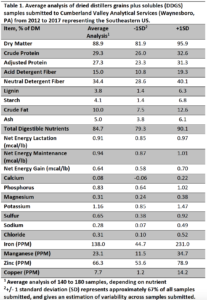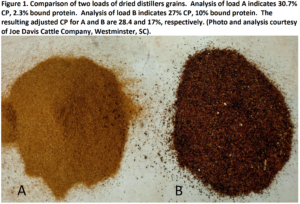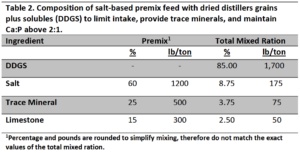Distillers grains offers supplementation options for beef cattle producers
Across much of the Southeast, many producers have experiencing ample rain and plenty of forage, therefore, winter supplementation is far from their thoughts. However, now is a great time to start planning ahead. Typically, three large factors taken into consideration when selecting a supplement are convenience, cost, and nutrients supplied. Often times, we combine the latter two and look at cost per unit of nutrient (e.g. $/lb of protein or energy). Unfortunately, sometimes nutrients supplied are sacrificed to maximize convenience or low cost.
Over past two decades, ethanol production has increased, and in turn, the byproduct of this industry (distillers grains) has become more available. The growing popularity of this feedstuff has led to extensive research evaluating distillers grains in beef cattle production. In fact, several studies have been conducted at the University of Georgia in an effort to evaluate its value, as well as ways to utilize it in a convenient manner. For the remainder of this article, the discussion will focus on dried distillers grains with solubles (DDGS) because this is the most common form utilized in the Southeast.
Nutrient value and mineral considerations
A summary of the nutrient analysis of approximately 130 DDGS samples submitted to Cumberland Valley Analytical  Services (Waynesboro, PA) from the Southeast is presented in Table 1. This byproduct can be fed as a protein source to replace other more expensive sources such as soybean meal. Distillers grains are also an excellent source of energy, often testing between 85 and 95% total digestible nutrients (TDN). The form of energy also makes distillers grains attractive for grazing cattle. Since the starch is removed, the energy derived from distillers grains is primarily digestible fiber and some fat.
Services (Waynesboro, PA) from the Southeast is presented in Table 1. This byproduct can be fed as a protein source to replace other more expensive sources such as soybean meal. Distillers grains are also an excellent source of energy, often testing between 85 and 95% total digestible nutrients (TDN). The form of energy also makes distillers grains attractive for grazing cattle. Since the starch is removed, the energy derived from distillers grains is primarily digestible fiber and some fat.
The mineral content of distillers grains should also be taken into consideration. Dried distillers grain is high in phosphorus (P) and sulfur (S), but low in calcium (Ca). Supplemental Ca should be provided to balance the high phosphorus levels to maintain a Ca:P ratio above 1.5:1. If this ratio stays low for extended periods of time, urinary calculi, or “water bellies” may occur. Also, excessive P excretion can have negative impact on water sources increasing the risk of algal bloom.
Sulfur tends to be high and can vary widely between ethanol plants and can be as high as 1%. The total ration should remain below 0.4% S to avoid issues such as Polioencephalomalacia, or more commonly referred to Polio or “brainers”.
Typically, DDGS should be limited to 30-40% of the total intake to avoid any negative impacts of excessive minerals while utilizing the protein and energy available.
Potential for heat damage
Distillers grains is high in moisture directly after the distilling process and

is typically dried down to make transportation and storage easier. If excess heat is applied during the d
rying process, the protein in DDGS can be heat-damaged and become bound protein. This reduces its utilization by cattle. This damage can easily be detected by visual inspection. Properly dried DDGS will have a light golden color; however, as it becomes heat damaged, it will darken in color and have a distinctive burntodor. Figure 1 illustrates the visual difference in an undamaged and a heat damaged load of DDGS. Analysis of load-A, golden in color, indicates 30.7% CP and 2.3% bound protein, while load-B, darker in color, is 26.9% CP and 9.9% bound protein. The adjusted CP, or available protein, for load –A and –B is 28.4% and 17%, respectively. This can create protein deficiencies if not taken into consideration when balancing a ration.
Utilizing DDG in a free-choice hot-mix
An on-farm trial was conducted in Northeast Georgia to develop a hot mix to allow producers to feed DDGS free choice but maintain intake to a safe level. In this trial, weaned heifers were offered tall fescue hay (56% TDN and 10% CP) with DDGS. At first, DDGS was offered free choice, however daily intake reached 12 lb/hd, twice the recommended level! A premix containing salt, limestone, and trace mineral (Table 2) was formulated to limit intake of DDGS while balancing the mineral content. This “hot mix” limited the intake of DDGS to approximately 40% of the daily dry matter intake for both developing heifers (7.8 lbs) and bred heifers (9.3 lb), and resulted

in average daily gains of 1.95 lb for weaned heifers and 1.07 lb for bred heifers. A hot mix is a supplement that contains an intake limiter and allows a producer to put out enough feed to last several days with intake remaining relatively constant across that time. This results in a feed strategy that is more convenient than feeding on a daily basis. This DDGS hot mix could easily be utilized for brood cows and bulls. In fact, several producers have reported success stories from utilizing this strategy.
Despite limitations with sulfur, phosphorus, and fat, distillers grains offer producers an additional option for protein and energy supplementation when cost is not prohibitive. Additional research has been conducted in Georgia evaluating distillers grains for developing bulls, stocker cattle, and finishing cattle. More information on distillers grains and the results of these studies can be found in UGA Bulletin 1482, Using Distillers Grains in Beef Cattle Diets. For more assistance developing beef cattle rations utilizing distillers grains, please contact your local Extension office.
